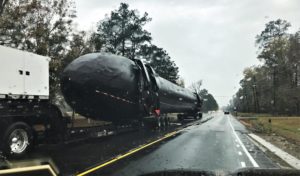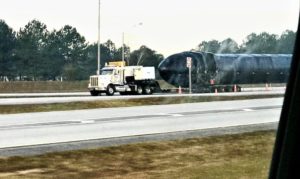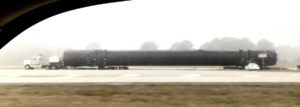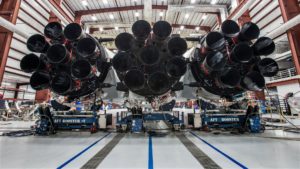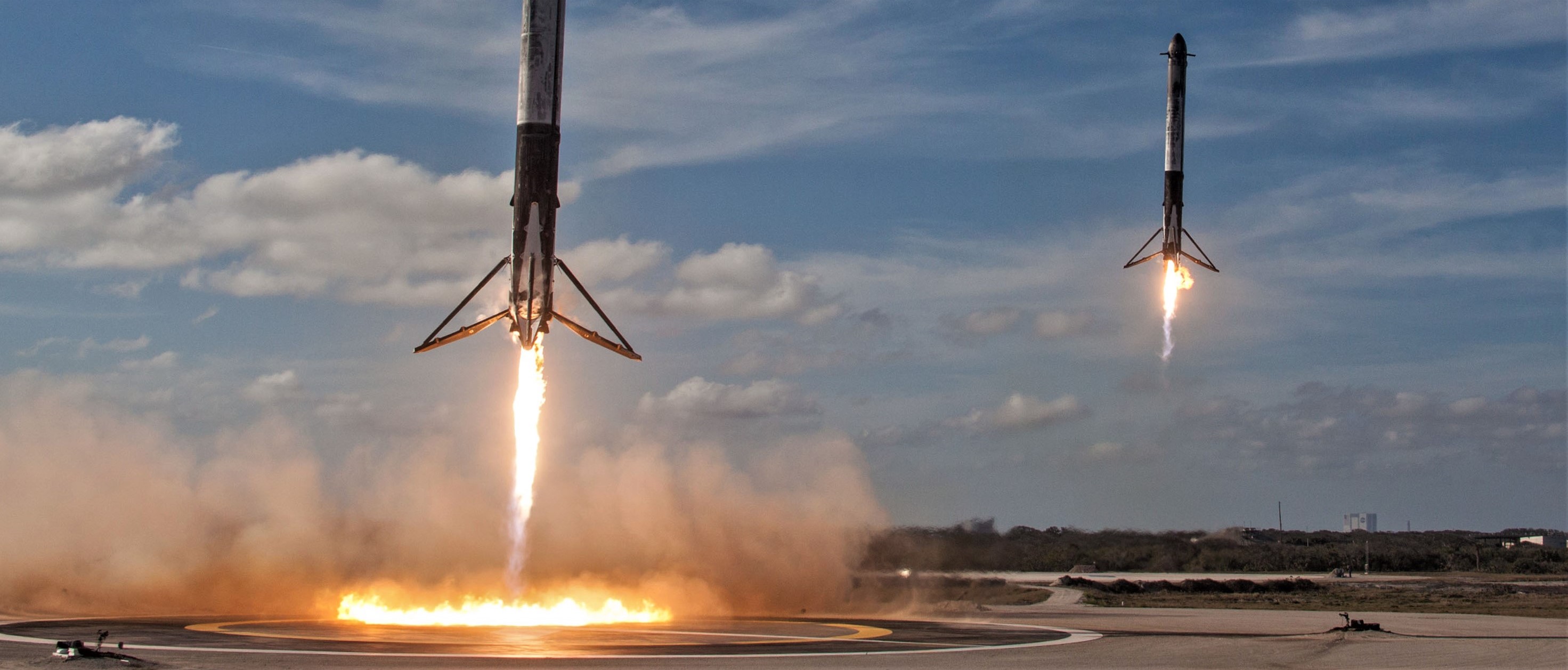

News
SpaceX’s next Falcon Heavy reaches milestone as third booster arrives in FL
A new SpaceX rocket was spotted traveling into Florida yesterday on its way to one of the company’s several Cape Canaveral booster storage and processing hangars. More likely than not, this particular booster is the second Falcon Heavy center core ever built, a heavily modified variant of Falcon 9’s first stage.
With the presumed center core’s arrival, all three Falcon Heavy boosters are now at or near SpaceX Launch Complex 39A, a major step forward for the second flight of the super heavy-lift launch vehicle, currently NET March 2019. Aside from the first stage, it appears that Falcon Heavy Flight 2’s payload fairing may have also arrived at Cape Canaveral around the end of January.

Captured by SpaceX Facebook group member Joshua Murrah on the morning of February 11th, the shrinkwrapped Falcon booster and truck were stopped at a weigh station on the border of Alabama and Florida, a now-common location for core spottings thanks to its adjacency to Mr. Murrah’s daily commute. No more than an 8-10 hour drive from Florida’s East Coast and Kennedy Space Center, the rocket likely arrived at its destination sometime within the last 12 or so hours.
While Falcon Heavy hardware would normally be expected to head straight for SpaceX’s hangar at Pad 39A, the only facility currently capable of launching the triple-booster rocket, the company faces a mild logistical challenge thanks to the terminally delayed launch debut of Crew Dragon. As of now, Crew Dragon, Falcon 9, and 39A’s transporter/erector (T/E) are integrated inside the pad’s hangar, leaving very little space for additional rocket processing as a result of the sheer scale of the T/E. Past photos of SpaceX’s 39A hangar illustrate that it can nominally house 4 or 5 Falcon boosters with ease, but space becomes far more limited once the T/E is rolled inside.
there might actually be juuuust enough room to literally fit them per FH Flight 1 processing pics, but only enough for Falcon Heavy integration if the TE remains outside. Will be very curious to see how SpaceX handles this, it's one hell of a logistical puzzle 😅 pic.twitter.com/D5BFXQnQ3V
— Eric Ralph (@13ericralph31) January 30, 2019
In essence, Falcon Heavy Flight 2 will likely have to wait until Crew Dragon has completed its launch debut before SpaceX technicians and engineers can begin integrating its three boosters and verifying that all is healthy, only the second time SpaceX will have performed those procedures. Crew Dragon’s uncrewed demonstration mission (DM-1) is currently scheduled for NET March 2nd, although there is a high probability that it will slip at least a few more days into March, if not further. Prior to its latest March 2nd launch target, Crew Dragon was expected to launch sometime in mid-to-late January as of December 2018, a date that has effectively remained 30+ days away ever since.
It’s ambiguous what the causes of those delays are and SpaceX and NASA clearly have no interest in directly tackling an explanation, but the most likely reason can be found in a painfully mundane reality: paperwork, worsened by a record-length US goverment shutdown. While both partners are likely culpable in some way, the fact remains that SpaceX has a long history of doing difficult things faster and cheaper than the old guard perceives as possible, while NASA has its own decades-long history of doing difficult things with extreme caution (for better or for worse).
- The second (and third) flight of Falcon Heavy is even closer to reality as the first new side booster heads to Florida after finishing static fire tests in Texas. (Reddit /u/e32revelry)
- SpaceX Facebook group member Joshua Murrah captured two great photos of the second Falcon Heavy side booster to arrive in Florida in the last month. (Joshua Murrah, 01/17/19)
- SpaceX Facebook group member Joshua Murrah also captured what is likely the third Falcon Heavy booster’s Florida arrival. (Joshua Murrah, 02/11/19)
- Falcon Heavy ahead of its inaugural launch. (SpaceX)
With any luck, Crew Dragon will successfully launch into orbit for the first time in the first several days of March, leaving enough buffer for SpaceX to rapidly integrate, checkout, and static-fire Falcon Heavy for an operational launch debut – carrying communications satellite Arabsat 6A – near the end of March. If all goes well, Falcon Heavy’s third launch – the USAF’s second Space Test Program mission (STP-2) – could occur as early as April 2019, potentially just a month after Flight 2.
News
Tesla launches in India with Model Y, showing pricing will be biggest challenge
Tesla finally got its Model Y launched in India, but it will surely come at a price for consumers.

Tesla has officially launched in India following years of delays, as it brought its Model Y to the market for the first time on Tuesday.
However, the launch showed that pricing is going to be its biggest challenge. The all-electric Model Y is priced significantly higher than in other major markets in which Tesla operates.
On Tuesday, Tesla’s Model Y went up for sale for 59,89,000 rupees for the Rear-Wheel Drive configuration, while the Long Range Rear-Wheel Drive was priced at 67,89,000.
This equates to $69,686 for the RWD and $78,994 for the Long Range RWD, a substantial markup compared to what these cars sell for in the United States.
🚨 Here’s the difference in price for the Tesla Model Y in the U.S. compared to India.
🚨 59,89,000 is $69,686
🚨 67,89,000 is $78,994 pic.twitter.com/7EUzyWLcED— TESLARATI (@Teslarati) July 15, 2025
Deliveries are currently scheduled for the third quarter, and it will be interesting to see how many units they can sell in the market at this price point.
The price includes tariffs and additional fees that are applied by the Indian government, which has aimed to work with foreign automakers to come to terms on lower duties that increase vehicle cost.
Tesla Model Y seen testing under wraps in India ahead of launch
There is a chance that these duties will be removed, which would create a more stable and affordable pricing model for Tesla in the future. President Trump and Indian Prime Minister Narendra Modi continue to iron out those details.
Maharashtra Chief Minister Devendra Fadnavis said to reporters outside the company’s new outlet in the region (via Reuters):
“In the future, we wish to see R&D and manufacturing done in India, and I am sure at an appropriate stage, Tesla will think about it.”
It appears to be eerily similar to the same “game of chicken” Tesla played with Indian government officials for the past few years. Tesla has always wanted to enter India, but was unable to do so due to these import duties.
India wanted Tesla to commit to building a Gigafactory in the country, but Tesla wanted to test demand first.
It seems this could be that demand test, and the duties are going to have a significant impact on what demand will actually be.
Elon Musk
Tesla ups Robotaxi fare price to another comical figure with service area expansion
Tesla upped its fare price for a Robotaxi ride from $4.20 to, you guessed it, $6.90.

Tesla has upped its fare price for the Robotaxi platform in Austin for the first time since its launch on June 22. The increase came on the same day that Tesla expanded its Service Area for the Robotaxi ride-hailing service, offering rides to a broader portion of the city.
The price is up from $4.20, a figure that many Tesla fans will find amusing, considering CEO Elon Musk has used that number, as well as ’69,’ as a light-hearted attempt at comedy over the past several years.
Musk confirmed yesterday that Tesla would up the price per ride from that $4.20 point to $6.90. Are we really surprised that is what the company decided on, as the expansion of the Service Area also took effect on Monday?
But the price is now a princely $6.90, as foretold in the prophecy 😂
— Elon Musk (@elonmusk) July 14, 2025
The Service Area expansion was also somewhat of a joke too, especially considering the shape of the new region where the driverless service can travel.
I wrote yesterday about how it might be funny, but in reality, it is more of a message to competitors that Tesla can expand in Austin wherever it wants at any time.
Tesla’s Robotaxi expansion wasn’t a joke, it was a warning to competitors
It was only a matter of time before the Robotaxi platform would subject riders to a higher, flat fee for a ride. This is primarily due to two reasons: the size of the access program is increasing, and, more importantly, the service area is expanding in size.
Tesla has already surpassed Waymo in Austin in terms of its service area, which is roughly five square miles larger. Waymo launched driverless rides to the public back in March, while Tesla’s just became available to a small group in June. Tesla has already expanded it, allowing new members to hail a ride from a driverless Model Y nearly every day.
The Robotaxi app is also becoming more robust as Tesla is adding new features with updates. It has already been updated on two occasions, with the most recent improvements being rolled out yesterday.
Tesla updates Robotaxi app with several big changes, including wider service area
News
Tesla Model Y and Model 3 dominate U.S. EV sales despite headwinds
Tesla’s two mainstream vehicles accounted for more than 40% of all EVs sold in the United States in Q2 2025.

Tesla’s Model Y and Model 3 remained the top-selling electric vehicles in the U.S. during Q2 2025, even as the broader EV market dipped 6.3% year-over-year.
The Model Y logged 86,120 units sold, followed by the Model 3 at 48,803. This means that Tesla’s two mainstream vehicles accounted for 43% of all EVs sold in the United States during the second quarter, as per data from Cox Automotive.
Tesla leads amid tax credit uncertainty and a tough first half
Tesla’s performance in Q2 is notable given a series of hurdles earlier in the year. The company temporarily paused Model Y deliveries in Q1 as it transitioned to the production of the new Model Y, and its retail presence was hit by protests and vandalism tied to political backlash against CEO Elon Musk. The fallout carried into Q2, yet Tesla’s two mass-market vehicles still outsold the next eight EVs combined.
Q2 marked just the third-ever YoY decline in quarterly EV sales, totaling 310,839 units. Electric vehicle sales, however, were still up 4.9% from Q1 and reached a record 607,089 units in the first half of 2025. Analysts also expect a surge in Q3 as buyers rush to qualify for federal EV tax credits before they expire on October 1, Cox Automotive noted in a post.
Legacy rivals gain ground, but Tesla holds its commanding lead
General Motors more than doubled its EV volume in the first half of 2025, selling over 78,000 units and boosting its EV market share to 12.9%. Chevrolet became the second-best-selling EV brand, pushing GM past Ford and Hyundai. Tesla, however, still retained a commanding 44.7% electric vehicle market share despite a 12% drop in in Q2 revenue, following a decline of almost 9% in Q1.
Incentives reached record highs in Q2, averaging 14.8% of transaction prices, roughly $8,500 per vehicle. As government support winds down, the used EV market is also gaining momentum, with over 100,000 used EVs sold in Q2.
Q2 2025 Kelley Blue Book EV Sales Report by Simon Alvarez on Scribd
-

 Elon Musk2 weeks ago
Elon Musk2 weeks agoTesla investors will be shocked by Jim Cramer’s latest assessment
-

 News3 days ago
News3 days agoTesla debuts hands-free Grok AI with update 2025.26: What you need to know
-

 Elon Musk1 week ago
Elon Musk1 week agoElon Musk confirms Grok 4 launch on July 9 with livestream event
-

 Elon Musk5 days ago
Elon Musk5 days agoxAI launches Grok 4 with new $300/month SuperGrok Heavy subscription
-

 News2 weeks ago
News2 weeks agoTesla Model 3 ranks as the safest new car in Europe for 2025, per Euro NCAP tests
-

 Elon Musk2 weeks ago
Elon Musk2 weeks agoxAI’s Memphis data center receives air permit despite community criticism
-

 News5 days ago
News5 days agoTesla begins Robotaxi certification push in Arizona: report
-

 Elon Musk2 weeks ago
Elon Musk2 weeks agoTesla scrambles after Musk sidekick exit, CEO takes over sales

